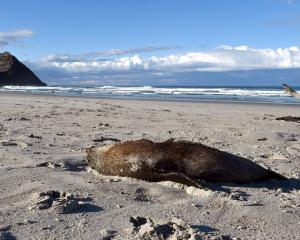
Now scientists have revealed how the same process unfolded when a similarly large quake hit the country some 1000 years ago, before settlers arrived here.
This pre-historic rupture of the Akatore Fault — just south of Dunedin — uplifted a large stretch of New Zealand's southeastern coast by 2m to 3m, and was likely a high magnitude event.
The Akatore Fault remained a bigger threat to Dunedin than the Alpine Fault which runs through the length of the South Island's alpine zone.
Earlier work revealed there had been periods of quiet with little happening on the fault for at least 100,000 years, before a trio of quakes struck within 10,000 years - two of those in the past 1300 years.
It was estimated the three quakes had magnitudes of between 6.8 and 7.4 and each displaced the ground by up to 2m vertically.
The fault runs about 20km onshore, between about Taieri Mouth and Toko Mouth, and possibly more than 40km offshore further north and south, though its precise length was not yet known.
The research team, led by geologist Professor Dave Craw, and biologist Professor Jon Waters, combined geological and genetic data to assess the impacts of the ancient quake.
"The old Akatore earthquake would have been similar in magnitude to the 2016 Kaikoura quake, with tens of kilometres of rocky coast affected, and the old shore lifted out of the water, well beyond the reach of the waves," Craw said.
Zoology PhD student Elahe Parvizi used DNA evidence to compare modern samples of kelp along the uplifted Akatore coast, against populations from either side of the raised region.
"We were astonished to find a modern DNA footprint of the ancient quake — with a clear genetic difference between kelp in the uplifted zone, versus stable populations outside the uplift zone," she said.
Similar to the recent Kaikoura earthquake, the ancient Akatore uplift was big enough to eliminate entire populations of intertidal species — which were subsequently replaced by genetically distinct lineages from outside the uplift zone.
This DNA "anomaly" was still detectable today, and represented a modern trace of the ancient Akatore quake.
"These findings show that a major disturbance event – even an ancient one like the Akatore quake — can leave a lasting DNA signature," Waters said.
"In the same way, major events happening now will leave a lasting legacy for the future."
The team now plans to use genetic approaches to shed new light on ancient earthquake disruption events elsewhere in New Zealand and overseas.
Their findings have been published in the international research journal Earth and Planetary Science Letters.
Comments
Oh !
Bring a very big quake on at St Clair and St Kilda Beaches and save South Dunedin from turning into a swamp.
Perhaps at the same time the harbour could be lifted and we could have NEW KIWI BUILD sections on the old tidal sand banks, so handy to town for our homeless and refugees.












